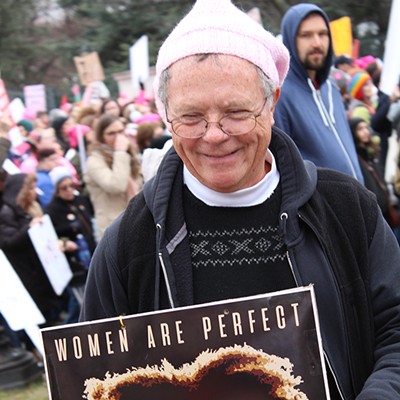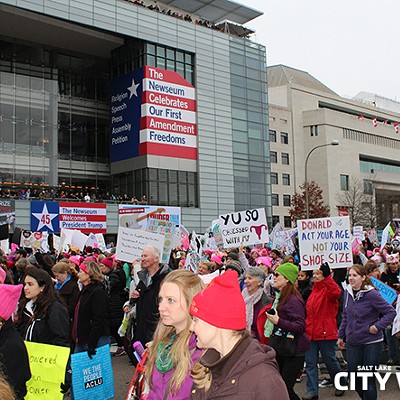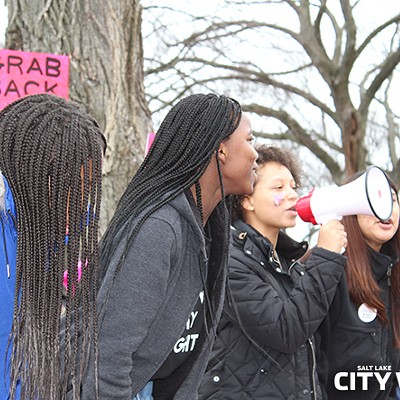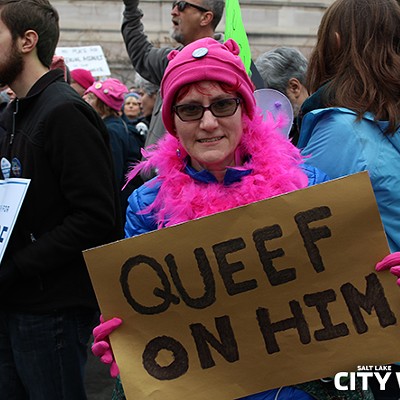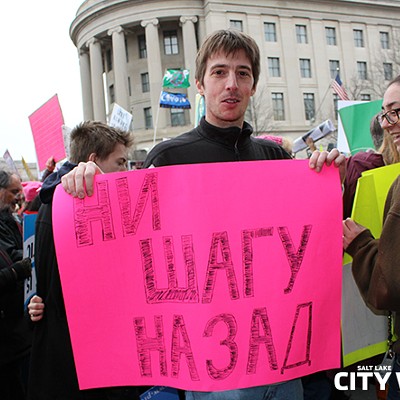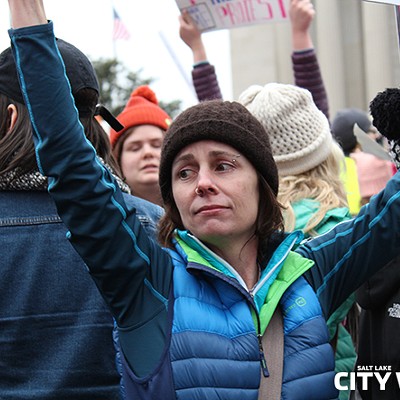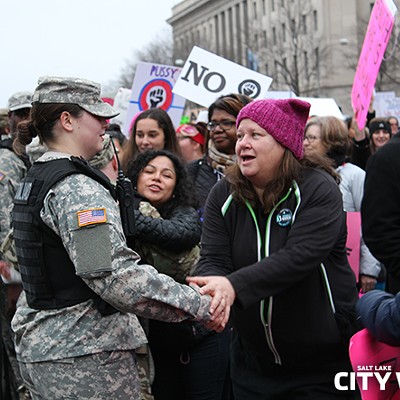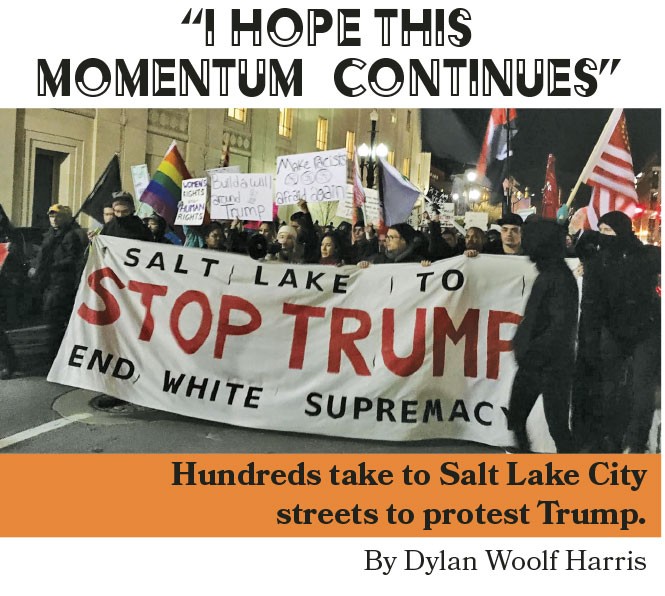
TRUMPOCALYPSE NOW!
Is there any hope for Planned Parenthood and climate change under the new regime? PLUS we take you inside the inauguration and the DC + SLC Women's Marches.
By Alastair Bland, Baynard Woods, Dylan Woolf Harris @dylantheharris and Katharine Biele @kathybieleIf President Trump actually believes all his campaign warnings about the threats of immigration, he should now be talking about ways to slow global warming as well. Rising sea levels, caused by the melting of the Antarctic and Greenland ice caps, probably will displace tens of millions of people in the decades ahead, and many might come to North America as refugees.
Climate change will cause a suite of other problems for future generations, and it's arguably the most pressing issue of our time. In December 2015, world leaders gathered in Paris to discuss strategies for curbing greenhouse-gas emissions, and scientists at every corner of the globe confirm that humans are facing a crisis. However, climate change is being nearly ignored by American politicians and lawmakers. It was not discussed in depth at all during this past election cycle's televised presidential debates. And, when climate change does break the surface of public discussion, it polarizes Americans like almost no other political issue. Some conservatives, including Trump, still deny there's even a problem.
"We are in this bizarre political state in which most of the Republican Party still thinks it has to pretend that climate change is not real," says Jonathan F.P. Rose, a New York City developer and author of The Well-Tempered City, which explores, in part, how low-cost green development can mitigate the impacts of rising global temperatures and changing weather patterns.
Rose says progress cannot be made in drafting effective climate strategies until national leaders agree there's an issue.
"We have such strong scientific evidence," he continues. "We can disagree on how we're going to solve the problems, but I would hope we could move toward an agreement on the basic facts."
That such a serious planetwide crisis has become a divide across the American political battlefield "is a tragedy" according to Peter Kalmus, an earth scientist with the Jet Propulsion Laboratory at Caltech in Pasadena, who agreed to be interviewed for this story on his own behalf (not on behalf of NASA, JPL or Caltech).
Kalmus warns that climate change is happening whether politicians want to talk about it or not.
"CO2 molecules and infrared photons don't give a crap about politics, whether you're liberal or conservative, Republican or Democrat or anything else," he says.
Slowing climate change will be essential, since adapting to all its impacts might be impossible. Governments must strive for greater resource efficiency, shift to renewable energy and transition from conventional to more sustainable agricultural practices.
America's leaders must also implement a carbon pricing system, climate activists say, that places a financial burden on fossil-fuel producers and reduces greenhouse-gas emissions. But there may be little to zero hope that such a system will be installed at the federal level now that Trump is in the White House. Trump has actually threatened to reverse any commitments the United States agreed to in Paris. Trump even selected a well-known skeptic of climate change, Myron Ebell, to head his U.S. Environmental Protection Agency transition team. Ebell is the director of the Center for Energy and Environment at the Competitive Enterprise Institute.
Steve Valk, communications director for the Citizens' Climate Lobby, says the presidential election results come as a discouraging setback in the campaign to slow emissions and global warming.
"There's no doubt that the steep hill we've been climbing just became a sheer cliff," he says. "But cliffs are scalable."
Valk says the American public must demand that Congress implement carbon pricing. He says the government is not likely to face and attack climate change unless voters force them to.
"The solution is going to have to come from the people," he says. "Our politicians have shown that they're just not ready to implement a solution on their own."
After Paris
There is no question the Earth is warming rapidly, and already this upward temperature trend is having impacts. It is disrupting agriculture. Glacial water sources are vanishing. Storms and droughts are becoming more severe. Altered winds and ocean currents are impacting marine ecosystems. So is ocean acidification, another outcome of carbon dioxide emissions. The sea is rising and eventually will swamp large coastal regions and islands. As many as 200 million people could be displaced by 2050. For several years in a row now, each year has been warmer than any previous year in temperature records, and by 2100 it may be too hot for people to permanently live in the Persian Gulf.
World leaders and climate activists made groundbreaking progress toward slowing these effects at the Paris climate conference. There, leaders from 195 countries drafted a plan of action to reduce global greenhouse gas emissions and steer the planet off its predicted course of warming. The pact, which addresses energy, transportation, industries and agriculture—and which asks leaders to regularly upgrade their climate policies—is intended to keep the planet from warming by 2.7 degrees Fahrenheit between pre-industrial years and the end of this century. Scientists forecast that an average global increase of 3.6 degrees Fahrenheit will have devastating consequences for humanity.
The United States pledged to cut greenhouse gas emissions by 26 percent from 2005 levels within a decade. China, Japan and nations of the European Union made similar promises. More recently, almost 200 nations agreed to phase out hydrofluorocarbons, extremely potent but short-lived greenhouse gases emitted by refrigerators and air conditioners, and reduce the emissions from the shipping and aviation industries.
But in the wake of such promising international progress—as 2016 becomes the third record-warm year in a row—many climate activists are disconcerted both by United States leaders' recent silence on the issue and by Trump's election. Mark Sabbatini, editor of the newspaper Icepeople in Svalbard, Norway, believes shortsighted political scheming has pushed climate change action to the back burner. He wants to see politicians start listening to scientists.
"But industry folks donate money and scientists get shoved aside in the interest of profits and re-election," Sabbatini says. He recently had to evacuate his apartment as unprecedented temperatures thawed out the entire region's permafrost, threatening to collapse buildings.
Short-term goals and immediate financial concerns distract leaders from making meaningful policy advances on climate.
"In Congress, they look two years ahead," Sabbatini continues. "In the Senate, they look six years ahead. In the White House, they look four years ahead."
The 300 nationwide chapters of the Citizens' Climate Lobby are calling on local governments and chambers of commerce across America to voice support for a revenue-neutral carbon fee. It's hoped is that leaders in Congress will hear the demands of the people. This carbon fee would impose a charge on producers of oil, natural gas and coal. As a direct result, all products and services that depend on or directly utilize those fossil fuels would cost more for consumers, who would be incentivized to buy less. Food shipped in from far away would cost more than locally grown alternatives. Gas for heating, electricity generated by oil and coal, and driving a car would become more expensive.
"Bicycling would become more attractive, and so would electric cars and home appliances that use less energy," says Kalmus, an advocate of the revenue-neutral carbon fee.
Promoting this fee system is essentially the Citizens' Climate Lobby's entire focus.
"This would be the most important step we take toward addressing climate change," Valk says.
By the carbon-fee system, the revenue from fossil fuel producers would be evenly distributed by the collecting agencies among the public, perhaps via a tax credit. Recycling the dividends back into society would make it a fair system, Valk explains, since poorer people—who tend to use less energy than wealthier people to begin with and are therefore less to blame for climate change—would come out ahead.
The system would also place a tariff on incoming goods from nations without a carbon fee. This would keep American industries from moving overseas and maybe even prompt other nations to set their own price on carbon.
But there's a problem with the revenue-neutral carbon fee, according to other climate activists: It doesn't support social programs that may be aimed at reducing society's carbon footprint.
"It will put no money into programs that serve disadvantaged communities who, for example, might not be able to afford weatherizing their home and lowering their energy bill, or afford an electric vehicle or a solar panel," according to Renata Brillinger, executive director of the California Climate and Agriculture Network. "It doesn't give anything to public schools for making the buildings more energy efficient, and it wouldn't give any money to farmers' incentive programs for soil building."
Brillinger's organization is advocating for farmers to adopt practices that actively draw carbon out of the atmosphere, like planting trees and maintaining ground cover to prevent erosion. Funding, she says, is needed to support such farmers, who may go through transitional periods of reduced yields and increased costs. California's cap-and-trade system, sets up an ample revenue stream for this purpose that a revenue-neutral system does not, according to Brillinger.
But Valk says establishing a carbon pricing system must take into account the notorious reluctance of conservatives in Congress.
"You aren't going to get a single Republican in Congress to support legislation unless it's revenue-neutral," he says. "Any policy is useless if you can't pass it in Congress."
Sequestering the farm
In Washington, D.C., the nation's leaders continue tussling over popular issues like immigration, taxes, healthcare, abortion, guns and foreign affairs.
Climate change activists wish they would be thinking more about soil. That's because stopping greenhouse gas emissions alone will not stop climate change. The carbon dioxide emitted through centuries of industrial activity will continue to drive warming unless it is removed from the air and put somewhere.
"There are only three places carbon can go," Brillinger says. "It can go into the atmosphere, where we don't want it; into the ocean, where we also don't want it because it causes acidification; or into soil and woody plants where we do want it. Carbon is the backbone of all forests and is a critical nutrient of soil."
But most of the Earth's soil carbon has been lost to the atmosphere, causing a spike in atmospheric carbon. In the 1700s, the Earth's atmosphere contained less than 280 parts per million of carbon dioxide, according to scientists. Now, we are at more than 400 and ticking upward. Climate experts generally agree that the atmospheric carbon level must be reduced to 350 or less if we are to keep at bay the most disastrous possible impacts of warming.
This is why farmers and the soil they work will be so important in mitigating climate change. By employing certain practices and abandoning other ones, farmers and ranchers can turn acreage into valuable carbon sinks—a general agricultural approach often referred to as "carbon farming."
Conventional agriculture practices tend to emit carbon dioxide. Regular tilling of the soil, for example, causes soil carbon to bond with oxygen and float away as carbon dioxide. Tilling also causes erosion, as do deforestation and overgrazing. With erosion, soil carbon enters waterways, creating carbonic acid—the direct culprit of ocean acidification. Researchers estimate that unsustainable farming practices have caused as much as 80 percent of the world's soil carbon to turn into carbon dioxide.
By carbon farming, those who produce the world's food can simultaneously turn their land into precious carbon sinks. The basic tenets of carbon farming include growing trees as windbreaks and focusing on perennial crops, like fruit trees and certain specialty grain varieties, which demand less tilling and soil disturbance.
Eric Toensmeier, a senior fellow with the climate advocacy group Project Drawdown and the author of The Carbon Farming Solution, says many other countries are far ahead of the United States in both recognizing the importance of soil as a place to store carbon and funding programs that help conventional farmers shift toward carbon farming practices. France, for instance, initiated a sophisticated program in 2011 that calls for increasing soil carbon worldwide by 0.4 percent every year. Healthy soil can contain 10 percent carbon or more, and France's program has the potential over time to decelerate the increase in atmospheric carbon levels.
Toensmeier is optimistic about the progress being made in the United States, too. The U.S. Department of Agriculture funds programs that support environmentally friendly farming practices that protect watersheds or enhance wildlife habitat, largely through planting perennial grasses and trees.
"And it turns out a lot of the practices they're paying farmers to do to protect water quality or slow erosion also happen to sequester carbon," Toensmeier explains.
He says it appears obvious that the federal government is establishing a system by which they will eventually pay farmers directly to sequester carbon. Such a direct faceoff with climate change, however, may be a few years away still.
Climate activists may even need to wait until 2021.
"First we need a president who acknowledges that climate change exists," Toensmeier says.
National politics and city reform
Climate reform advocates still talk about Bernie Sanders' fiery attack on fracking as a source of global warming in the May primary debate with Hillary Clinton.
"If we don't get our act together, this planet could be 5 to 10 degrees warmer by the end of this century," Sanders said. "Cataclysmic problems for this planet. This is a national crisis."
Sanders was not exaggerating. The Earth has already warmed by 1.7 degrees Fahrenheit since 1880, and it's getting hotter. Even with the advances made in Paris, the world remains on track to be 6.1 degrees Fahrenheit warmer by 2100 than it was in pre-industrial times, according to a United Nations emissions report released in early November. The authors of another paper published in January in the journal Nature predicted temperatures will rise as much as 10 degrees Fahrenheit.
In light of the scientific consensus, conservatives' denial of climate change looks childish at best and dangerous at worst. In low-lying Florida—a state more vulnerable to the rising sea—an unofficial policy from its Republican leadership has effectively muzzled state employees from even mentioning "climate change" and "global warming" in official reports and communications. Republican senator Ted Cruz suggested NASA focus its research less on climate change and more on space exploration, according to The Christian Science Monitor.
Perhaps most frightening of all is the president's stance: Trump said in a 2012 tweet that global warming is a Chinese hoax. In January 2014, during a brief spell of cold weather, he asked via Twitter, "Is our country still spending money on the GLOBAL WARMING HOAX?"
While most of the world remains poised to advance emissions-reduction goals, Trump is aiming in a different direction. During the election, the Trump-Pence website vowed to "unleash America's $50 trillion in untapped shale, oil and natural gas reserves, plus hundreds of years in clean coal reserves." His webpage concerning energy goals only mentions reducing emissions once, and it makes no mention of climate change or renewable energy.
While meaningful action at the federal level is probably years away, progress is coming at the local level—even in communities led by Republicans, according to Rose. That, he says, is because local politicians face a level of accountability from which national leaders are often shielded.
"At the city level, mayors have to deliver real results," Rose says. "They have to protect their residents and make wise investments on behalf of their residents. The residents see what they're doing and hold them accountable."
Restructuring and modifying our cities, which are responsible for about half of America's carbon footprint, "will be critical toward dealing with climate change," Rose says.
"On the coast, we'll have sea-level rise," he predicts. "Inland, we'll have flooding and heat waves. Heat waves cause more deaths than hurricanes."
Simply integrating nature into city infrastructure is a very low-cost but effective means for countering the changes that are coming, Rose says. Many cities, for example, are planting thousands of street trees. Trees draw in atmospheric carbon as they grow and, through shade and evaporative cooling effects, can significantly reduce surface temperatures by as much as 6 degrees Fahrenheit in some circumstances, Rose says.
Laws and policies that take aim at reduced emissions targets can be very efficient tools for generating change across entire communities. However, Kalmus believes it's important that individuals, too, reduce their own emissions through voluntary behavior changes, rather than simply waiting for change to come from leaders and lawmakers.
"If you care about climate change, it will make you happier," he says. "It makes you feel like you're pioneering a new way to live. For others, you're the person who is showing the path and making them realize it's not as crazy as it seems."
Kalmus, who lives in Altadena, Calif., with his wife and two sons, has radically overhauled his lifestyle to reduce his carbon footprint. Since 2010, he has cut his own emissions by a factor of 10—from 20 tons per year to just 2, by his own estimates. This personal transformation is the subject of his forthcoming book, Being the Change: Live Well and Spark a Climate Revolution, due out later this year.
Kalmus rides a bike most places, eats mostly locally grown food, raises some of it in his own yard, has stopped eating meat and—one of the most important changes—has all but quit flying places.
He hopes to serve as a model and help spark a transition to an economy that does not depend on constant growth, as ours currently does. One day, he believes, it will be socially unacceptable to burn fossil fuel, just as it's verboten to waste water in drought-dried California. The oil industry will eventually become obsolete, he predicts.
"We need to transition to an economy that doesn't depend on unending growth," Kalmus says.
Unless we slow our carbon emissions and our population growth now, depletion of resources, he warns, will catch up with us.
"We need to shift to a steady-state economy and a steady-state population," he says. "Fossil-fueled civilization cannot continue forever."
Though Americans now have a president who is essentially advocating for climate change, Valk, at the Citizens' Climate Lobby, expects time—and warming—to shift voter perspectives.
"As more and more people are personally affected by climate change, like those recently flooded out in Louisiana and North Carolina," he says, "people of all political persuasions will see that acting on climate change is not a matter of partisan preferences, but a matter of survival."
Dozens of police officers block off the corner at 12th and Massachusetts Avenue in Washington, D.C., gripping their batons and big canisters of pepper spray, faces obscured behind shields, as nearly 100 activists who had already been arrested are cordoned off behind them, waiting to be processed.
Protesters line the other side of the street. More and more arrive, chanting, yelling. "Let them go!"
A trail of pink smoke cuts through the air. There is the sound of a sting ball grenade and several officers open up with long orange streams of chemical-warfare pepper spray. Many people reported that rubber bullets were also fired.
"Because, today ... we are transferring power from Washington, D.C., and giving it back to you, the American People."
Earlier, a woman who said she lived in the neighborhood, was standing at the battle lines screaming at both sides, her body wrapped in an American flag, her face burned by pepper spray, now caked with milk of magnesia.
"Why are you doing this?" she wailed.
"For too long, a small group in our nation's Capital has reaped the rewards of government while the people have borne the cost. Washington flourished—but the people did not share in its wealth."
Officers run at people holding their billy clubs in both hands at throat level. (Dalton Bennett, a Washington Post reporter was thrown to the ground).
Now they tackle a woman on the street, and use tall Clydesdale horses to menace anyone getting too close to the tackled protester.
"The establishment protected itself, but not the citizens of our country. Their victories have not been your victories; their triumphs have not been your triumphs; and while they celebrated in our nation's capital, there was little to celebrate for struggling families all across our land."
Before the ruckus began, the streets of D.C. were weirdly empty, a ghost town nothing like what we had seen in previous years, especially Obama's record-setting first inauguration.
"We're not seeing big crowds," said Lacy MacAuley, a D.C. resident and organizer for DisruptJ20 (a collection of groups that came together for the inauguration protests). "We haven't seen any area where we the protesters don't outnumber Trump supporters."
The ever-growing melee in Northwest D.C. around 12th and 13th streets began small enough. I was wandering around at the makeshift headquarters for DisruptJ20. I saw a small group of five young people wearing all black start to walk away with purpose. I followed them. They pulled on their masks, but suddenly appeared lost. "Where are they?" they asked.
I started to scan the street and saw it, the mass of black shirts they were looking for. We all ran toward them. By the time I reached them, they, too, were running, chased by police on cycles—motor and bike—swerving almost as if to mow them down. A protester threw a trash can into the street. It rolled into a motorbike, forcing it to stop. A sign from in front of a store went flying through the air.
Other officers came in from the other side. The group—which had allegedly been using Black Bloc tactics of property destruction and, it was announced later, will now likely face felony charges—was cornered. That's when the police went crazy with the pepper spray and the batons—for the first time of the day (earlier, activists had chained themselves together to block a checkpoint into the inauguration and the police had not arrested anyone).
"What truly matters is not which party controls our government, but whether our government is controlled by the people. January, 20, 2017, will be remembered as the day the people became the rulers of this nation again. The forgotten men and women of our country will be forgotten no longer."
Suddenly, a man appears walking through the crowd followed by others and the mood changes, briefly.
"I am the president of America," the man says. He is wearing a boot on his head, has a long gray beard and Rasputin eyes. "I am also an amateur hostage negotiator."
His name is Vermin Supreme and he actually did run for president, as he has since 2004 (he promised a free pony for every American).
A little later, the air again filled with pepper spray and what seemed like a gas, Vermin Supreme gets right in front of the police line and squawks out the National Anthem, Jimi Hendrix style, through a bullhorn.
Another officer sprays gas into the crowd and sting ball grenades sound around the corner, where the heat of the action has moved. Lines of riot police face the protesters, some of whom threw bricks and concrete.
"Officers did not deploy tear gas and did deploy pepper spray and other armaments," D.C.'s Interim Police Chief Peter Newsham told Democracy in Conflict. "A full accounting of the control devices deployed will be made available when we have it."
"The time for empty talk is over. Now arrives the hour of action."
The same multinational corporations Trump railed against in the campaign had their windows smashed—including Starbucks and Bank of America.
"So to all Americans, in every city near and far, small and large, from mountain to mountain, and from ocean to ocean, hear these words: You will never be ignored again."
The day ends with a burning limousine in the streets, a new symbol of our unity.
"Your courage and goodness and love will forever guide us along the way."
The guerilla chaos that filled the air like the pepper spray on Friday is washed away the next days as half a million people pour into the the city for the Women's March, filled with righteous anger, solidarity and community.
At one point, after the march officially ends, a barricade blocking off Pennsylvania Avenue, leading toward the White House is knocked down. Marchers make their way to the fence on the other end, where Secret Service agents stand. An African-American woman walks up right beside them. "Whose house? Our house!" she chants, her fist raised in the air.
With additional reporting by Brandon Soderberg.
It was all about representation because, of course, these women have no representation. We heard it over and over as we left for the Women's March on Washington. "Represent Us!"
We were going for a catharsis of sorts. Maybe there would be some effect on the congressmen who saw hundreds of thousands of women marching to the Capitol. But no one really expected to change the minds of the giddy new administration taking office as it pumps up its arms and assumes that women are less than men, that women should not have the right to choose what happens to their bodies, and that most women are frankly sixes at best.
No, it wasn't an anti-Trump or pro-Hillary demonstration, although speakers lashed out at the toxic words of the new president. Well, Ashley Judd and Madonna might have taken it to the next level, and now there's talk of investigating the latter for threatening to blow up the White House. OK, Madonna. We all know her only explosions are on stage, but we also know there is little, if any, humor in this presidency.
Things went pretty smoothly, except when Michael Moore was cut short during a rant against the Democratic National Committee, the same happening to Charlotte Johansen when she might have gone on a bit too long about Planned Parenthood.
This was a '60s throwback march by the new, older and grayer hippie, the disenchanted millennial, the LGBTQ community, artists, parents and men, people of all colors and kinds—despite the multiple posts before the marches asserting that these were all about "privileged white women." White women did start the movement, but a white woman started the NAACP, too. I asked several black women at the march what they thought about the white-privilege stuff. Their answers: "I've never heard that." Total strangers stopped in coffee shops, on the street and in the metro station just to thank each other and hear one another's stories.
A friend and I carried panels designed by Utah artist Jann Haworth, the co-creator of The Beatles' Sgt. Pepper's Lonely Hearts Club Band album cover. Haworth had created an installation of seven panels depicting strong women throughout history—partly because Shirley Temple was about the only "woman" on the original album cover. The 2-by-4-foot panels drew comments of stunned appreciation.
The march had a lot of rules, permeated by a certain amount of fear. We weren't supposed to carry sticks to hold posters—or knock anyone upside the head. A lot of women thought maybe they should wear diapers, despite the presence of many porta-potties and the unintentionally comic "Don's Johns" portable toilets.
Some marchers brought masks, vinegar and swim goggles just in case they got tear-gassed. None of that happened. As the march headed toward the White House, there was talk of protesters blocking the path. But not even the police could contain the sea of pink "pussy" hats and posters. While thousands discarded their posters in front of the White House, others broke off, idly passing a "Bikers for Trump" jam in the park.
We heard that drones and helicopters buzzed the Los Angeles march. The only things that broke the peace of the Washington march were a few pigeons and a random balloon that had escaped someone's grasp.
The inauguration itself was a gray-clouded drizzling event, although the soon-to-be-president noted that the rain stopped just as he emerged. Because, you know, he commanded it. The skies remained overcast and gloomy into the day of the march. We arrived around 8 a.m. to meet the 700 other Utah delegates at the Air and Space Museum. Buses full of Utah women had rolled in from Philadelphia and Boston as it was nearly impossible to book flights to D.C. Not all of them gathered as a group—probably because the unexpectedly large crowds were being redirected around the Mall.
Marchers—a kind of euphemism since there was more standing and a lot less marching—stood for up to six hours as speakers, rappers and feminist icons galvanized the crowds. The messages were that women are under attack, that we are becoming a nation of ignorance and that we were marching for the 53 percent of white women who "voted for the other guy." "Women are the wall and Trump will pay," said one. "I can respect the presidency but not the president," said another. But the overarching message was that voting counts and voices must be heard.
President Donald Trump told Americans in his inaugural address that starting now, Washington, D.C., is listening to the people.
But Trump—not known accepting criticism graciously—might be less inclined to hearken to the hundreds who took to Salt Lake City streets Friday night.
A crowd of marchers chanted out their opposition to Trump's approval by white nationalists, his hard-line immigration rhetoric and his ties to anti-LGBTQ voices, among other things.
On the very night that Trump assumed the role of Leader of the Free World, Students for a Democratic Society's University of Utah chapter organized a downtown protest.
Ian Decker, a Democratic Society member, said he wanted to ensure that Trump's radical mores weren't normalized.
"We want to start from Day 1," Decker said. "We want Trump to know that if he makes one single regressive move, it's going to be met with crisis; that we are ready to bring the country to a stop if he takes away the rights of working people."
Theresa Nielson, also with the Students for a Democratic Society, hopes to see a groundswell movement among the historically downtrodden.
"We're hoping to mobilize working-class people, and students and oppressed people to fight against Donald Trump," she said, "as well as other members of the ruling class that don't have our interests in mind."
Nielson said she was heartened to see the colossal turnout.
At times, protesters expanded across the width of the road. The mass was so large that chants toward the front often didn't match up with those in the back.
"I hope this momentum continues," she said.
The demonstration commenced in front of the Wallace F. Bennett Federal Building, wound northwest around City Creek, continued up Main Street and then trudged up State Street to the Utah State Capitol.
Protester Rebecca Barker was also impressed by the size of the group, but wished that more people would have stood against Trump before the election.
"It feels a little too late, but it's what we need to do now," she said. "We just want to show that the people have the power still. We want to be heard."
Spencer Cannon agreed. "I've never seen a crowd this big in Salt Lake," he said. "It's good to see a lot of fight back. These are the battlegrounds, fighting for our rights. For everybody's rights."
Trump was prominently in the crosshairs Friday night, but the organizers didn't give Democrats or former President Barack Obama a pass. On the Capitol steps, a young man shouted anti-Democrat and anti-Trump slogans.
"The Democrats have failed to give us any real solutions," Decker said later. "If you look at Obama, he's deported more people than anyone else in U.S. history. There was job growth but it was temporary jobs or part-time jobs—things that don't support families."
A majority of people, however, were protesting the 45th president. Marcia Culley waved a pole that had a mock-Trump head atop.
"We're just so against Trump," she said. "He's against everything we believe in. He's against women, gays, minorities, immigration. Just bad from the get-go."
Students for a Democratic Society also aim to bolster the campus as a sanctuary space where undocumented immigrants don't have to look over their shoulders for fear of deportation.
Latest in Cover Story
Readers also liked…
-
Forget the family pedigree—Robert F. Kennedy Jr should not be the next president of the United States
Trojan Horse
- Jun 21, 2023
-
Women decry harassment and toxic culture at St. George auto dealership
Men at Work
- Oct 11, 2023







